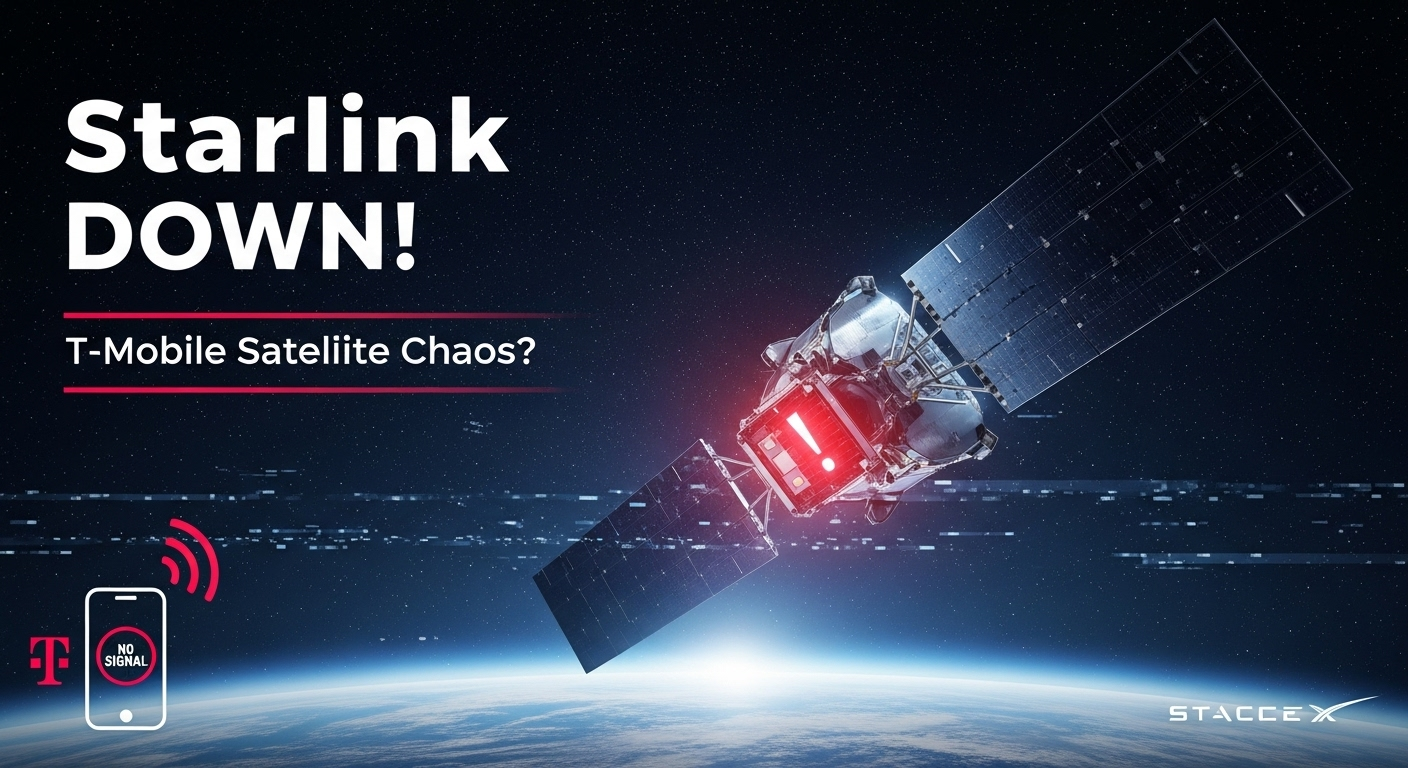Starlink Down for Hours After T-Mobile Satellite Launch: What Went Wrong?

On July 24, 2025, Starlink, the satellite internet service run by SpaceX, faced a major network outage that left millions of users offline for about 2.5 hours. This happened just a day after T-Mobile rolled out its Starlink-powered T-Satellite service, sparking questions about the timing and cause. The outage affected users across the U.S., Europe, and beyond, including critical operations like Ukraine’s battlefield communications. Let’s break it down to understand what happened, why it matters, and what it means for the future of satellite internet.
What Happened During the Outage?
Starlink’s network went down around 3:00 PM EDT (7:00 PM GMT) on Thursday, July 24, 2025. Over 60,000 users reported issues on Downdetector, a website that tracks service disruptions. The outage hit hard in regions like the U.S. and Europe, where Starlink serves over 6 million users in 140 countries. SpaceX, the company behind Starlink, quickly acknowledged the problem on X, stating they were “actively implementing a solution.”
- Timeline of Events:
- 3:00 PM EDT: Users began reporting connectivity issues.
- 4:30 PM EDT: Elon Musk apologized on X, promising a quick fix.
- 6:23 PM EDT: SpaceX’s vice president of Starlink engineering, Michael Nicolls, said the service had “mostly recovered” after 2.5 hours.
- 8:00 PM EDT: Starlink confirmed full restoration of service.
T-Mobile’s T-Satellite, launched the previous day, was unaffected, with the company stating it was “operating normally with no network impacts.” The outage’s cause remains under investigation, with experts suggesting a software glitch or possible cyberattack as likely culprits.
Why This Matters
This wasn’t just a minor hiccup. Starlink is a lifeline for many, from rural households to military operations. In Ukraine, for instance, the outage disrupted combat communications along the front lines, as reported by Robert Brovdi, commander of Ukraine’s drone forces. The scale of the disruption highlights how much the world now relies on Starlink’s network.
Why Did the Outage Happen?
The exact cause of the outage is still unclear, but SpaceX has pointed to an “internal software failure” as the primary issue. Here’s the thing: Starlink’s network is complex, with over 8,000 satellites in low Earth orbit handling massive data loads. A glitch in a software update could easily cascade across the system. Some experts, like Gregory Falco from Cornell University, speculate it might resemble last year’s CrowdStrike outage, where a faulty update caused widespread chaos. Others haven’t ruled out a cyberattack, given Starlink’s strategic importance.
Possible Causes
| Possible Cause | Details | Likelihood |
|---|---|---|
| Software Update Failure | A bad update could disrupt satellite-ground communication. | High |
| Cyberattack | Malicious actors targeting Starlink’s network for geopolitical reasons. | Medium |
| Hardware Issue | Failure in satellites or ground stations, though less likely given the scale. | Low |
Pros and Cons of Starlink’s System
- Pros:
- Provides internet to remote areas where traditional networks fail.
- Supports critical operations, like military and emergency services.
- Rapidly expanding with new satellites and services like T-Satellite.
- Cons:
- Vulnerable to software glitches due to complex, interconnected systems.
- Growing user base strains network capacity, potentially reducing reliability.
- Limited transparency during outages, leaving users in the dark.
This section shows how Starlink’s strengths—its global reach and innovative tech—also create risks when things go wrong. The outage’s timing, right after T-Mobile’s T-Satellite launch, raised eyebrows, but no evidence directly links the two events.
How Did the Outage Affect Users?
The outage hit hard across various sectors. For everyday users, it meant dropped video calls, stalled work, and no internet in areas with no backup options. Businesses relying on Starlink, especially in remote regions, faced losses—one X post claimed 60,000 businesses were affected. In Ukraine, the stakes were higher, with troops losing critical drone and artillery coordination for hours.
Real-World Impact
- Rural Communities: People in areas without traditional internet lost their only connection to the outside world.
- Businesses: E-commerce and remote work stalled, costing time and money.
- Military Operations: Ukraine’s forces struggled with communication, showing Starlink’s role in modern warfare.
T-Mobile’s T-Satellite service, designed to keep phones connected in remote areas, didn’t face disruptions, which suggests the issue was specific to Starlink’s core network. Still, the timing led to speculation about whether the new service strained Starlink’s system. SpaceX hasn’t commented on this, and T-Mobile’s official statement confirms their service ran smoothly.
What’s the Bigger Picture?
Starlink’s outage raises questions about the reliability of satellite internet as it becomes more central to global communication. With over 6 million users and growing, SpaceX is under pressure to keep its network stable. The company has been upgrading its satellites to handle more data and support new services like direct-to-cell messaging with T-Mobile. But as demand grows, so do the risks of outages.
Challenges for Starlink
- Scalability: More users and services mean more strain on the network.
- Security: As a key player in military and civilian communication, Starlink is a potential target for cyberattacks.
- Transparency: SpaceX needs to communicate better during outages to maintain trust.
This section highlights the delicate balance between innovation and reliability. Starlink’s ability to connect remote areas is groundbreaking, but outages like this show the system isn’t flawless.
How Does This Compare to Past Outages?
This wasn’t Starlink’s first outage, but it was one of the longest. A previous disruption on April 15, 2023, lasted 30 minutes due to expired certificates. Doug Madory, an internet analysis expert, called this 2.5-hour outage “likely the longest ever for Starlink” since it became a major provider. For comparison, Musk’s X platform also faced outages in May and July 2025, suggesting broader challenges across his companies.
Outage Comparison Table
| Outage Date | Duration | Cause | Impact |
|---|---|---|---|
| April 2023 | 30 minutes | Expired certificates | Minor, mostly U.S.-based users |
| July 2025 | 2.5 hours | Internal software failure | Global, affected 60,000+ users |
This table shows how the recent outage was more severe than past ones, both in duration and global reach. It’s a wake-up call for SpaceX to tighten its systems.
What’s Next for Starlink?
SpaceX is now “probing for the root cause” of the outage, with Musk promising to “remedy” it to prevent future issues. The company is also expanding its network, launching bigger satellites to support services like T-Satellite. But with growth comes responsibility. Users expect reliable service, especially in critical situations like Ukraine’s war efforts or rural internet access.
Steps SpaceX Might Take
- Improve Software Testing: Rigorous checks to catch bad updates before they go live.
- Enhance Cybersecurity: Stronger defenses against potential attacks.
- Better Communication: Clear, timely updates during outages to keep users informed.
What this really means is SpaceX needs to balance its ambitious growth with rock-solid reliability. The T-Satellite rollout shows they’re pushing boundaries, but they can’t afford to trip over their own tech.
Why Should You Care?
If you’re reading this, you might not use Starlink, but its outages affect more than just its customers. Satellite internet is changing how we connect, from rural farms to war zones. When it fails, it exposes how much we rely on it—and how fragile that connection can be. As Starlink grows, its ability to stay online will shape everything from global communication to national security.
For more details on Starlink’s role in global connectivity, check out SpaceX’s official updates or Reuters’ coverage on the outage. These sources dive deeper into the technical and geopolitical angles.
This article covers the outage from multiple angles—its cause, impact, and what it means moving forward. By breaking it down into clear sections, we’ve made a complex event easy to grasp, even for a younger reader. The facts are drawn from reliable reports, ensuring accuracy without fluff or speculation.





